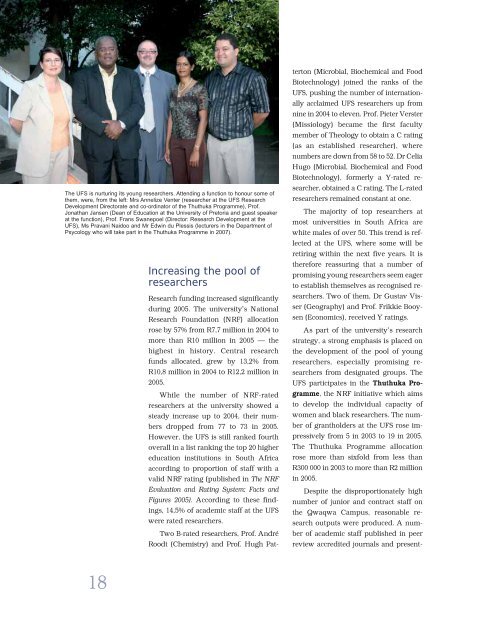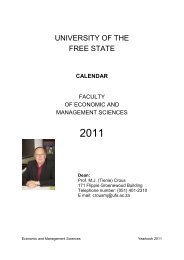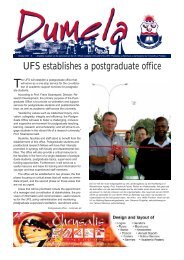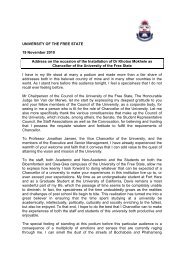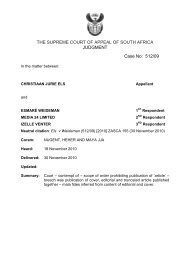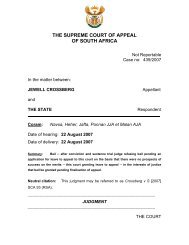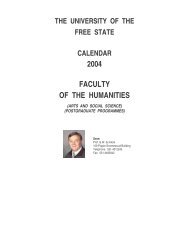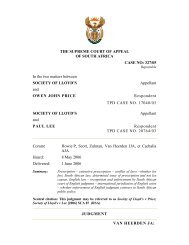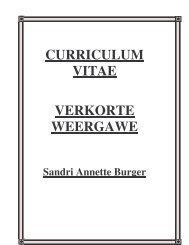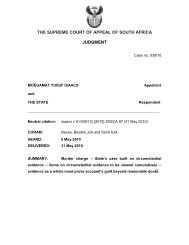Jaaroorsig - University of the Free State
Jaaroorsig - University of the Free State
Jaaroorsig - University of the Free State
Create successful ePaper yourself
Turn your PDF publications into a flip-book with our unique Google optimized e-Paper software.
The UFS is nurturing its young researchers. Attending a function to honour some <strong>of</strong><strong>the</strong>m, were, from <strong>the</strong> left: Mrs Annelize Venter (researcher at <strong>the</strong> UFS ResearchDevelopment Directorate and co-ordinator <strong>of</strong> <strong>the</strong> Thuthuka Programme), Pr<strong>of</strong>.Jonathan Jansen (Dean <strong>of</strong> Education at <strong>the</strong> <strong>University</strong> <strong>of</strong> Pretoria and guest speakerat <strong>the</strong> function), Pr<strong>of</strong>. Frans Swanepoel (Director: Research Development at <strong>the</strong>UFS), Ms Pravani Naidoo and Mr Edwin du Plessis (lecturers in <strong>the</strong> Department <strong>of</strong>Psycology who will take part in <strong>the</strong> Thuthuka Programme in 2007).Increasing <strong>the</strong> pool <strong>of</strong>researchersResearch funding increased significantlyduring 2005. The university’s NationalResearch Foundation (NRF) allocationrose by 57% from R7,7 million in 2004 tomore than R10 million in 2005 — <strong>the</strong>highest in history. Central researchfunds allocated, grew by 13,2% fromR10,8 million in 2004 to R12,2 million in2005.While <strong>the</strong> number <strong>of</strong> NRF-ratedresearchers at <strong>the</strong> university showed asteady increase up to 2004, <strong>the</strong>ir numbersdropped from 77 to 73 in 2005.However, <strong>the</strong> UFS is still ranked fourthoverall in a list ranking <strong>the</strong> top 20 highereducation institutions in South Africaaccording to proportion <strong>of</strong> staff with avalid NRF rating (published in The NRFEvaluation and Rating System: Facts andFigures 2005). According to <strong>the</strong>se findings,14,5% <strong>of</strong> academic staff at <strong>the</strong> UFSwere rated researchers.Two B-rated researchers, Pr<strong>of</strong>. AndréRoodt (Chemistry) and Pr<strong>of</strong>. Hugh Pat-terton (Microbial, Biochemical and FoodBiotechnology) joined <strong>the</strong> ranks <strong>of</strong> <strong>the</strong>UFS, pushing <strong>the</strong> number <strong>of</strong> internationallyacclaimed UFS researchers up fromnine in 2004 to eleven. Pr<strong>of</strong>. Pieter Verster(Missiology) became <strong>the</strong> first facultymember <strong>of</strong> Theology to obtain a C rating(as an established researcher), wherenumbers are down from 58 to 52. Dr CeliaHugo (Microbial, Biochemical and FoodBiotechnology), formerly a Y-rated researcher,obtained a C rating. The L-ratedresearchers remained constant at one.The majority <strong>of</strong> top researchers atmost universities in South Africa arewhite males <strong>of</strong> over 50. This trend is reflectedat <strong>the</strong> UFS, where some will beretiring within <strong>the</strong> next five years. It is<strong>the</strong>refore reassuring that a number <strong>of</strong>promising young researchers seem eagerto establish <strong>the</strong>mselves as recognised researchers.Two <strong>of</strong> <strong>the</strong>m, Dr Gustav Visser(Geography) and Pr<strong>of</strong>. Frikkie Booysen(Economics), received Y ratings.As part <strong>of</strong> <strong>the</strong> university’s researchstrategy, a strong emphasis is placed on<strong>the</strong> development <strong>of</strong> <strong>the</strong> pool <strong>of</strong> youngresearchers, especially promising researchersfrom designated groups. TheUFS participates in <strong>the</strong> Thuthuka Programme,<strong>the</strong> NRF initiative which aimsto develop <strong>the</strong> individual capacity <strong>of</strong>women and black researchers. The number<strong>of</strong> grantholders at <strong>the</strong> UFS rose impressivelyfrom 5 in 2003 to 19 in 2005.The Thuthuka Programme allocationrose more than sixfold from less thanR300 000 in 2003 to more than R2 millionin 2005.Despite <strong>the</strong> disproportionately highnumber <strong>of</strong> junior and contract staff on<strong>the</strong> Qwaqwa Campus, reasonable researchoutputs were produced. A number<strong>of</strong> academic staff published in peerreview accredited journals and present-18


